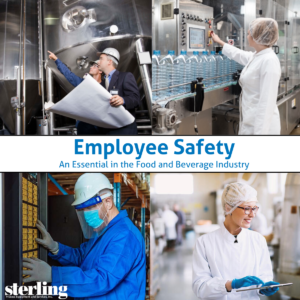Safety in the workplace for employees is a top concern of most businesses. In the food and beverage industry specifically, workers are surrounded by different machines, tanks, chemicals, and diseases that carry many unique dangers and risks. Regulations put into place by the Occupational Safety and Health Administration reduce the probability of hazards in the workplace and are aimed at promoting an overall safety baseline in plants. 
These regulations include:
- Mandatory guard rails
- Non-slip floors
- Ventilation
- Checking equipment
- Mandatory personal protective equipment
- Overall implementing safe practices in day-to-day operations
Additionally, there are other steps and requirements employers need to consider helping to ensure safety in their workplace:
- Have an emergency action plan.
Having an emergency action plan has many components including:
a. Hazard Communication Standard. This helps to ensure everyone knows about hazardous chemicals in the workplace and how to protect themselves. We found this sample plan from OSHA.b. Emergency Action Plan Standard. This describes actions employees should take to ensure their safety in a fire or other emergency situation.
c. Fire Safety and Exit Routes. Not only should employers have a fire prevention plan. And since accidents can happen, employers should also have exit routes displayed throughout their facility so employees know where and how to exit the building in case of a fire.
d. Walking/Working Surface Safety Plan. Falls from heights as well as on working surfaces are among the leading causes of serious work-related injuries and deaths. GripTread products can help minimize slips and falls in the workplace.
e. Medical and First Aid. Employers are required to provide medical and first aid personnel and supplies consistent with the hazards of the workplace.
- Know OSHA requirements that apply to your workplace.
There are a number of OSHA standards that may apply to your workplace, and we find the following checklist, though not comprehensive, to be helpful in identifying other key standards that may apply to ensure you’re in compliance:a. If you have employees who operate machinery you may be subject to OSHA’s Machine Guarding requirements.
b. IF your employees service or maintain machines or equipment that could start up unexpectedly or release hazardous energy, you may be subject to “Lockout/Tagout” requirements.
c. To determine if your employees are required to wear personal protective equipment (PPE), employers need to perform an assessment of each operation in the workplace.
d. If your employees are exposed to excessive noise, you may be required to implement a Hearing Conservation program.
e. If your employees operate powered industrial trucks (i.e., forklifts) you may be required to have powered industrial trucks standards in place.
- Recordkeeping, reporting and posting.
In some cases, employers are required to keep records of workplace injuries and illnesses. Regardless of size or industry, all employers must report all work-related inpatient hospitalizations, amputations, losses of an eye within 24 hours and all work-related fatalities within 8 hours. Additionally, all employers are required to post the OSHA poster (or state plan equivalent) in a prominent location in the workplace.
We hope you have found these tips useful, but it’s important to remember that a work environment is generally not safe unless the entirety of the business is committed to practicing ways to promote safety in the workplace. It starts at the top and trickles down to each employee.

